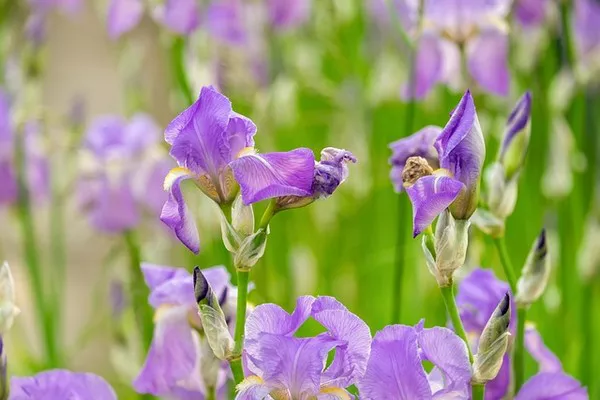In the vast tapestry of botanical wonders, the sweet pea flower stands as a testament to nature’s artistry. With its delicate petals and enchanting fragrance, the sweet pea has captured the hearts of garden enthusiasts and florists alike. In this comprehensive guide, we will delve into the captivating world of the sweet pea flower, exploring its appearance, varieties, and the cultural significance that has made it a cherished favorite.
Unraveling the Appearance of the Sweet Pea Flower
1. Petals and Colors
The sweet pea flower, scientifically known as Lathyrus odoratus, is celebrated for its exquisite and dainty appearance. Its petals are soft and ruffled, creating an alluring and feminine quality. The blossom typically features a symmetrical structure with five petals, forming a butterfly-like shape. These petals boast a broad spectrum of colors, ranging from pastel hues to vibrant shades, including lavender, pink, red, white, and blue. The play of colors on the delicate canvas of the sweet pea makes it a stunning addition to any garden or floral arrangement.
2. Foliage and Stem
The sweet pea plant showcases elegant foliage that complements its blossoms. The leaves are compound and consist of two leaflets, providing a lush backdrop to the colorful flowers. The stems of the sweet pea are slender yet sturdy, often climbing or trailing, making them a popular choice for trellises and arbors. This characteristic growth habit not only enhances the visual appeal of the plant but also allows for creative landscaping possibilities.
3. Fragrance
One of the most distinctive features of the sweet pea flower is its captivating fragrance. The blossoms emit a sweet and intoxicating scent that has been described as a harmonious blend of honey and orange blossoms. This alluring fragrance adds an olfactory dimension to the sweet pea’s charm, making it a sought-after choice for cut flower arrangements and perfumery.
Exploring Varieties of Sweet Pea Flowers
1. Spencer Sweet Peas
Named after plant breeder Silas Cole Spencer, Spencer sweet peas are renowned for their large, ruffled blossoms and an extended blooming period. These varieties often boast vibrant colors and are favored for their suitability as cut flowers.
2. Grandiflora Sweet Peas
Grandiflora sweet peas are recognized for their larger blooms, which can measure up to two inches in diameter. They come in an array of captivating colors and exhibit a vigorous growth habit, making them ideal for ornamental purposes.
3. Old-Fashioned Heirloom Varieties
Heirloom sweet peas offer a nostalgic charm, harkening back to the historical origins of this beloved flower. These varieties often feature a diverse range of colors and may have unique characteristics that set them apart, appealing to those with a penchant for heritage gardening.
4. Dwarf Sweet Peas
For those with limited space or looking to enhance the borders of their garden, dwarf sweet peas provide a compact alternative. Despite their smaller stature, these varieties retain the enchanting qualities of their larger counterparts, making them a versatile choice for various garden settings.
Cultural Significance and Symbolism
Beyond its aesthetic appeal, the sweet pea flower carries cultural significance and symbolism that has resonated through the ages. In the language of flowers, the sweet pea is often associated with sentiments of pleasure, gratitude, and departure. It has become a popular choice for expressing appreciation, making it a favored gift for birthdays, anniversaries, and other joyous occasions.
The sweet pea also holds historical importance, as it gained popularity during the Victorian era. Victorian enthusiasts embraced the sweet pea as a symbol of delicate pleasure and the fleeting nature of beauty, further enhancing its allure in gardens and floral arrangements.
Cultivation Tips for Sweet Pea Enthusiasts
1. Planting and Soil Requirements
Sweet peas thrive in well-draining soil with a slightly alkaline to neutral pH. Planting should be done in early spring, allowing the seeds to establish before the heat of summer. Incorporating organic matter into the soil and providing a trellis or support structure will encourage healthy growth.
2. Sunlight and Watering
Sweet peas flourish in full sunlight but appreciate some shade during the hottest part of the day. Regular watering is essential, especially during dry spells, to ensure the soil remains consistently moist. Mulching around the base of the plants helps retain moisture and suppress weeds.
3. Pruning and Deadheading
To encourage continuous blooming, regular pruning and deadheading are crucial. Removing spent flowers not only promotes new growth but also prevents the plant from diverting energy into seed production. This practice extends the overall blooming period and enhances the visual appeal of the sweet pea display.
Conclusion
In the intricate world of horticulture, the sweet pea flower stands as a testament to nature’s ability to captivate the human spirit. With its delicate petals, enchanting fragrance, and cultural significance, the sweet pea has woven itself into the fabric of gardens and floral arrangements worldwide. Whether adorning trellises, cascading from hanging baskets, or gracing bouquets, the sweet pea continues to be a symbol of beauty, joy, and appreciation. As we unravel the layers of this botanical gem, we find not just a flower but a living masterpiece that invites us to celebrate the simple pleasures and fleeting moments of life.


